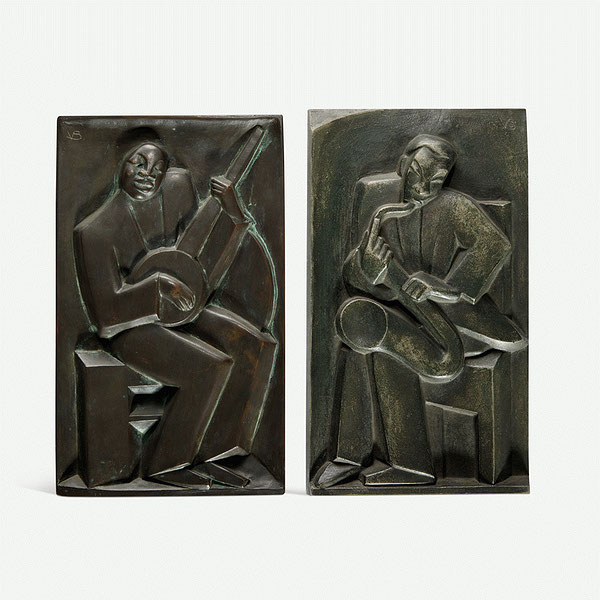NW-25
$12,500
Pair of Art Deco Patinated Bronze Plaque of Jazz Musicians by Béla Vörös
Pair of Art Deco Patinated Bronze Plaque of Jazz Musicians by Béla Vörös Property from an Important New York Collection second plaque dimensions: 12 3/4 x 7 5/8 x 1 1/4 in Signed: initialized VB.France: circa 1927 In 1928, he exhibited at the Salon d'Automne as well as at the Salon des Tuileries and the Salon des Artistes Décorateurs . He worked with the ceramist Édouard Cazaux, providing models of shapes and decorations. During this period he continued to participate in the exhibitions of the Hungarian group UME (New Union of Artists). In 1931, he appeared at the exhibition of Hungarian artists in Paris, published by Bonaparte, and presented African-inspired bronze bracelets and rings at the Colonial Exhibition . The following year, he moved to Nice, where he made a living producing ivory-carved art and decorative objects. They were noticed by the great fashion designer Paul Poiret , who commissioned buttons, umbrella handles, and jewelry from him. He exhibited at the Nice Fine Arts Salon between 1932 and 1936. In 1938, he returned to Paris, where he overcame difficult years, notably losing his wife, the painter Ilona Karikás, deported from Hungary in 1944. In 1945, Vörös moved to Boulogne-Billancourt and worked in his studio in Sèvres . Works by Béla Vörös were presented at the Franco-Hungarian exhibition of the School of Europe in Budapest in 1947 alongside works by Bonnard , Braque , Csaky, Villon , etc. and at the exhibition of the France-Hungary association at the Galerie de Bussy in Paris, whose honorary committee included great names such as Braque, Matisse and Villon. In 1947 and 1948, he participated in the contemporary art exhibition in Boulogne-Billancourt alongside its most illustrious representatives, Léger , Matisse , Picasso , etc.
- width
- 7.5
- height
- 13 in.
- depth
- 1.25
- condition
- Very good condition. When viewed firsthand, the two plaques present with slightly different yet complementary textures. One plaque presents with slightly more concentrated verdigris and oxidation to the recessed areas, consistent with age and the natural evolution of the medium. The patina with some rubbing and discolouration to the raised elements. The reverse of each plaque is fitted with a hook permitting installation on a wall.
Circa 1928

